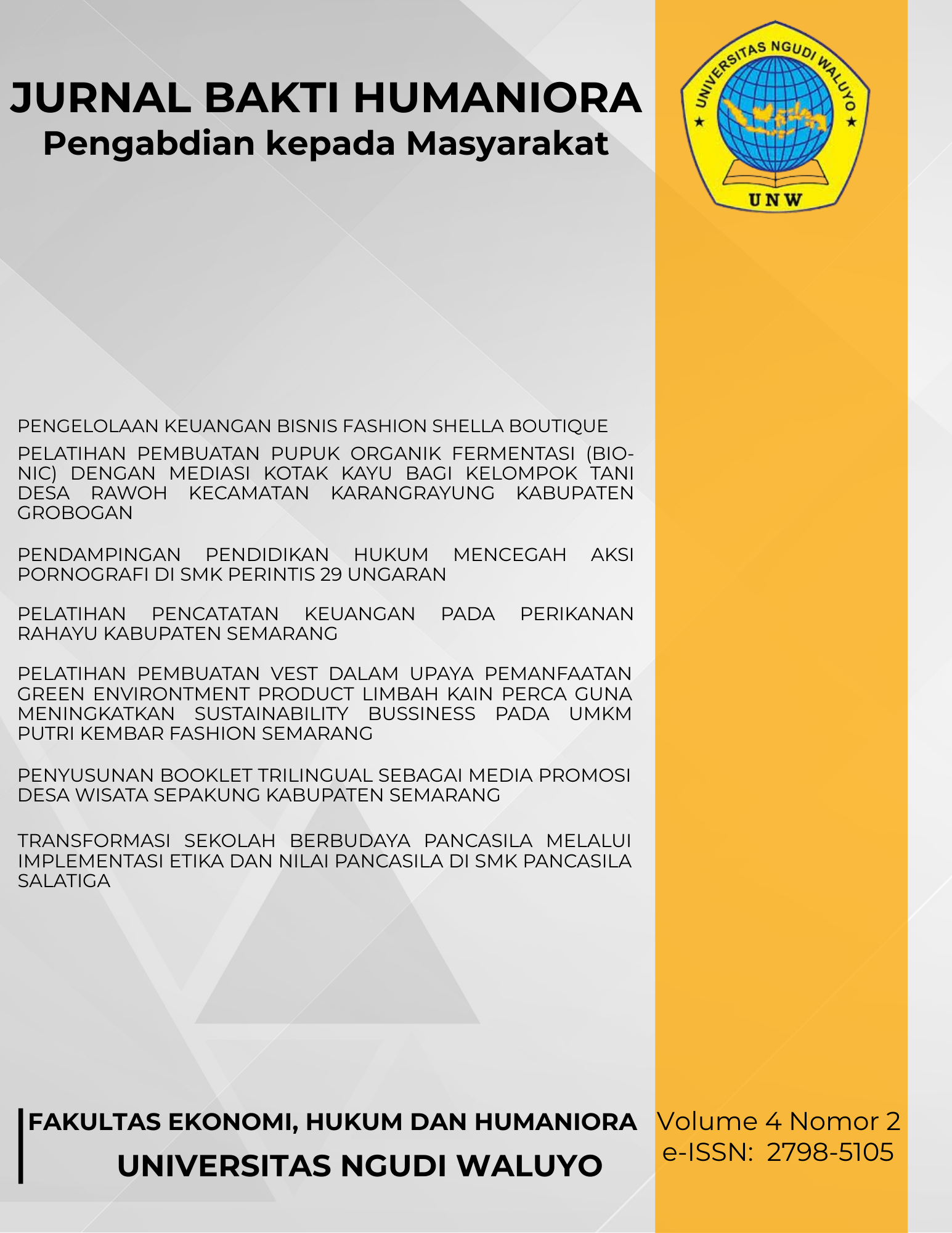PELATIHAN PEMBUATAN PUPUK ORGANIK FERMENTASI (BIO-NIC) DENGAN MEDIASI KOTAK KAYU BAGI KELOMPOK TANI DESA RAWOH KECAMATAN KARANGRAYUNG KABUPATEN GROBOGAN
DOI:
https://doi.org/10.35473/jbh.v4i2.3390Abstract
The training on the production of fermented compost fertiliser (Bio-Nic) using the wooden box method was conducted to improve the knowledge and skills of members of the Rawoh Village Farmer Group, Karangrayung District, Grobogan. This activity aims to utilise organic waste in their environment so that it can be processed into high quality compost. The wooden box method was chosen because it is practical, efficient and suitable for use in a rural environment. The training included material on basic composting techniques, the benefits of compost for plants and the use of the wooden box method in the fermentation process. The results of this training are expected to increase agricultural productivity and reduce dependence on chemical fertilisers. The evaluation showed that the participants successfully understood and practised the techniques taught and were enthusiastic about applying the technology in their fields.
Abstrak
Pelatihan pembuatan pupuk kompos fermentasi (Bio-Nic) dengan metode kotak kayu ini dilaksanakan untuk meningkatkan pengetahuan dan keterampilan anggota Kelompok Tani Desa Rawoh, Kecamatan Karangrayung, Grobogan. Kegiatan ini bertujuan untuk memanfaatkan limbah organik yang ada di sekitar lingkungan mereka, sehingga dapat diolah menjadi pupuk kompos yang berkualitas tinggi. Metode kotak kayu dipilih karena praktis, efisien, dan cocok diterapkan di lingkungan pedesaan. Pelatihan ini mencakup materi tentang teknik dasar pembuatan kompos, manfaat kompos bagi tanaman, serta penerapan metode kotak kayu dalam proses fermentasi. Hasil dari pelatihan ini diharapkan mampu meningkatkan produktivitas pertanian dan mengurangi ketergantungan pada pupuk kimia. Evaluasi menunjukkan bahwa para peserta berhasil memahami dan mempraktikkan teknik yang diajarkan, serta menunjukkan antusiasme dalam mengimplementasikan teknologi ini di lahan mereka.
References
Aklis, N., & Masyrukan, M. (2016). Penanganan Sampah Organik Dengan Bak Sampah Komposter di Dusun Susukan Kelurahan Susukan Kecamatan Susukan Kabupaten Semarang. Warta, 19(1), 74–82.
Dinas Penanaman Modal dan Pelayanan Terpadu Satu Pintu (2022) Feasibiity Study Pengelolaan Sampah TPA Ngembak, Kabupaten Grobogan.
Erickson Sarjono Siboro, Edu Surya, & Netti Herlina. (2013). Pembuatan Pupuk Cair Dan Biogas Dari Campuran Limbah Sayuran. Jurnal Teknik Kimia USU, 2(3), 40– 43.
M.D. Fairus, A.N. Rabiatul, M.S. Siti, S.I. Zitty, A.O. Nur (2012). Heavy metals composition of indoor dust in nursery schools building, Procedia - Social and Behavioral Sciences, 38, pp. 169-175
Fifendy, M., Eldini, E., & Irdawati, I. (2013). Pengaruh Pemanfaatan Molase Terhadap Jumlah Mikroba Dan Ketebalan Nata Pada Teh Kombucha. In Prosiding Semirata FMIPA Universitas Lampung (pp. 67–72).
Indriyanti, D. R., Banowati, E., & Margunani, M. (2015). Pengolahan Limbah Organik Sampah Pasar Menjadi Kompos. Jurnal Abdimas, 19(1), 43–48.
Lia Handayani, Nurhayati, Cut Rahmawati, & Meliyana (2019). Pelatihan Pembuatan Pupuk Organik Cair (POC) dari Limbah Dapur bagi Ibu-Ibu Desa Paya Kecamatan Trienggadeng Kabupaten Pidie Jaya. Jurnal Pengabdian Kepada Masyrakat, 2(2), 359- 365.
Meriatna, M., Suryati, S., & Fahri, A. (2018). Pengaruh Waktu Fermentasi dan Volume Bio Aktivator EM4 (Effective Microorganisme) pada Pembuatan Pupuk Organik Cair (POC) dari Limbah Buah-Buahan. Jurnal Teknologi Kimia Unimal, 7(1), 13– 29.
Nur, T., Noor, A. R., & Elma, M. (2016). Pembuatan Pupuk Organik Cair Dari Sampah Organik Rumah Tangga Dengan Penambahan Bioaktivator EM4 (Effective Microorganisms). Konversi, 5(2).
Ramaditya, I., Hardiono, & Ali As, Z. (2017). Pengaruh Penambahan Bioaktivator EM-4 (Effective microorganism) dan Mol (Mikroorganisme Lokal) Nasi Basi Terhadap Waktu Terjadinya Kompos. Jurnal Kesehatan Lingkungan, 14(1), 415– 423.
Siswati, N. D., Theodorus, H., & Eko S, P. W. (2009). Kajian Penambahan Effective Microorganisms (EM4) Pada Proses Dekomposisi Limbah Padat Industri Kertas. Buana Sains, 9(1), 63–68.
Sulistyorini, L. (2005). Pengolahan Sampah Dengan Cara Menjadikannya Kompos.
Jurnal Kesehatan Lingkungan, 2(1), 77–84.
Downloads
Published
Issue
Section
License

This work is licensed under a Creative Commons Attribution-NonCommercial-ShareAlike 4.0 International License.
Copyright notice:
- Authors retain copyright and grant the journal right of first publication with the work simultaneously licensed under a Creative Commons Attribution License that allows others to share the work with an acknowledgement of the work's authorship and initial publication in this journal.
- Authors are able to enter into separate, additional contractual arrangements for the non-exclusive distribution of the journal's published version of the work (e.g., post it to an institutional repository or publish it in a book), with an acknowledgement of its initial publication in this journal.
- Authors are permitted and encouraged to post their work online (e.g., in institutional repositories or on their website) prior to and during the submission process, as it can lead to productive exchanges, as well as earlier and greater citation of published work (See The Effect of Open Access)



